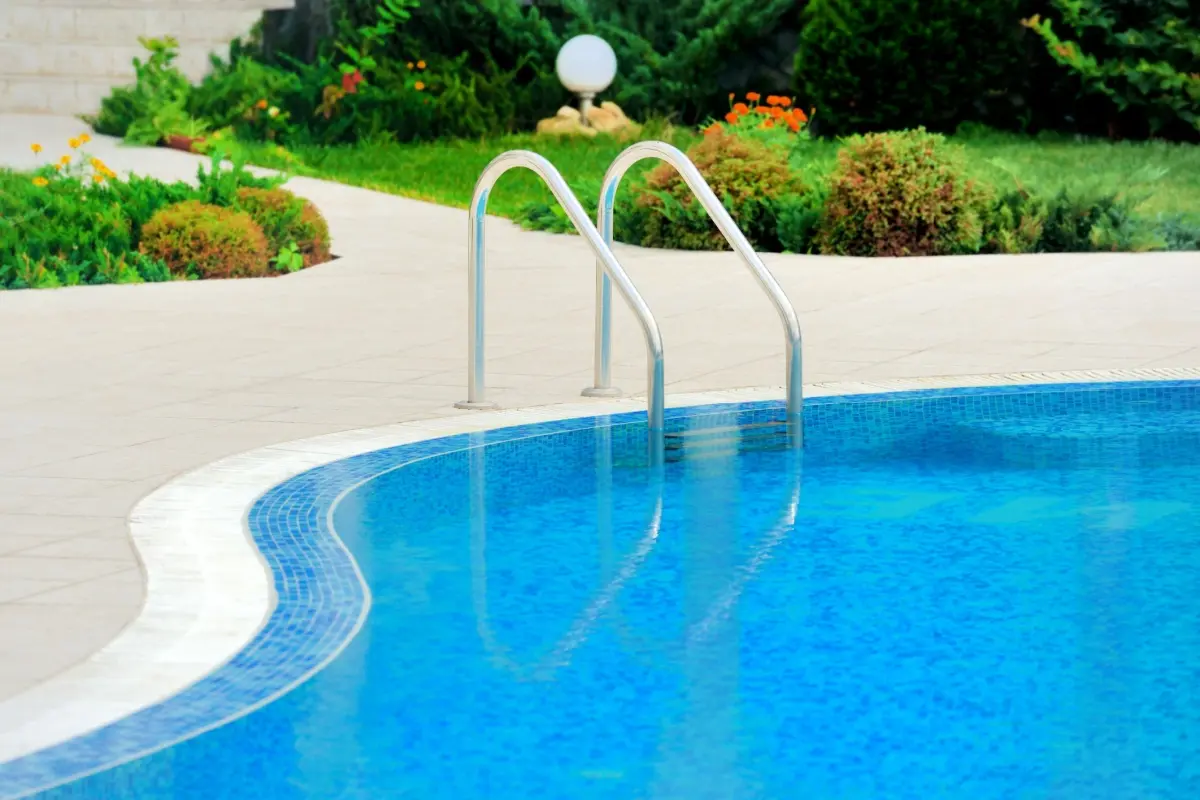A backyard pool can be a blessing on a hot summer day. But the more you use it, the more you need to maintain it. If your pool’s surface layer has deteriorated over time, you need to resurface it so it lasts many more seasons. Here are a few pool resurfacing tips to consider and the costs associated with the project.
Pool resurfacing, or “pool refinishing,” is the process of replacing your swimming pool’s older, worn-out surface layer with a new one. A pool’s surface layer stays in constant contact with water, chlorine, and sun, which can cause the concrete, plaster, or vinyl to crack or peel over time. Pool resurfacing helps restore the pool’s appearance and extend its lifespan by resealing the surface with a new coat of material. Also, upgrading your pool increases the value of your house if you decide to sell it in the future.
Your pool will give you several warning signs suggesting your pool may need to be resurfaced, refinished, or restored. Here are some red flags to watch for:
Addressing these problems through pool resurfacing can restore your pool’s beauty and keep your family safe before the situation worsens. Pool refinishing can get expensive, but private pool financing can be an affordable way to fund construction and repair costs without making a significant upfront payment.
Swimming pool surfaces are usually made of three materials: concrete, fiberglass, and vinyl — all prone to leaks and discoloration. Vinyl pools require a different resurfacing method than concrete or fiberglass pools, and a reputable pool contractor can help you determine the best way to resurface it. Here is a general overview of how pool resurfacing works for pools of all types.
Concrete pools can last 50 years or more, but their surfaces can wear down after 10 to 15 years. Resurfacing a concrete or gunite pool will cost between $6,000 and $15,000, depending on the pool size.

If you notice cracks or chips, your concrete surface might be flaking (spalling). Resurfacing requires removing any loose or delaminated plaster before prepping the surface for its new layer. Your contractor may use a sandblaster or a process known as chemical etching to roughen the surface.
Then, they’ll apply a new coat using plain plaster covered with paint, fiberglass or tile, or aggregate plaster, which is considered a finished surface. The new surface must be cured for several days before use.
Due to UV exposure, fiberglass pools have smooth and non-porous surfaces but can fade, blister, or crack. To resurface a fiberglass pool, a pool contractor will start by draining the pool and checking for osmosis bubbles (blisters), cracks, or delamination.
Then, they’ll prepare the surface for its new coat using a sander and repair the damaged areas by applying a resin mix filler and hardener. After smoothing the surface, they’ll add a primer coat and a new gel or epoxy finish.
Resurfacing a fiberglass pool ranges from $7,000 to $15,000, depending on the size of the pool and the type of coating you choose.
Vinyl pools last anywhere from five to nine years. While you may be able to repair small vinyl tears with a pool patch, it’s usually best to replace the entire liner if it’s nearing the end of its lifespan.
Replacing vinyl pool liners typically requires professional help. Pool liner replacement costs range from $2,500 to $5,500 on average, depending on the size of your pool and the liner you choose.
The specific pool restoration processes can vary by pool type. Here is a quick recap of what you can expect when tackling a pool resurfacing project:
Your contractor will completely drain the pool before beginning any work and turn off all electrical equipment connected to the pool, such as lights and pumps. It’s best to let a professional drain and dispose of pool water so they can do it according to environmental regulations.
In an empty pool, it’s easier to spot structural issues, such as cracks, spalling, or delamination. The pro will inspect drains, lights, and fittings for signs of wear or damage and clean any surface stains before determining the best way to repair the older layer.
Before any restoration materials can be applied to the damaged layer, the pool surface must be free of dirt and debris. Your professional might use a pressure washer or sander to clean the surface. Then, depending on the extent of the damage, they’ll apply a filter or patch to repair any cracks or chips.
Next, your pool restoration contractor will use primer epoxy to bond the old surface with the new finish. Once it dries, they’ll begin the finished work required to paint, retile, or resurface the pool.
Depending on your finish, it may require multiple coats to install the new surface fully. Chat with your contractor about your options and whether plaster, paint, aggregate finishes, gel coats, or liners are best for your pool.
The new pool surface must be cured for several days to ensure it lasts and each layer adheres correctly. During this time, you must keep the pool moist by filling it with water and maintaining the water level.
Once the new surface has cured, your contractor will slowly refill the pool, observing to ensure the new layer is solid and does not leak.
During the resurfacing process, it’s essential to maintain the chemical balance of the new pool water so the pool doesn’t grow bacteria. Your pool contractor will balance the chlorine, pH, and alkalinity according to your environment and climate. Generally speaking, a pH level between 7.4 and 7.6 is best for keeping the pool water fresh while also protecting the pool’s surface.
Before reopening the swimming pool, ensure all fittings, ladders, lights, and other accessories are installed and functioning correctly. Develop a regular schedule for cleaning and maintenance. It’s recommended to clean your pool at least once a week and check water chemistry and adjustments at least once every week.
Take a splash and wind down on a hot summer day!
Regular maintenance is necessary if you want your newly resurfaced pool to serve its purpose for a long time. Vacuum the pool weekly to remove dirt and debris that could harm the outer layer. Brush the walls and floor during your regular cleanups to prevent algae buildup.

Then, test the water’s pH and adjust the chlorine levels as needed to keep the water clean and fresh. Pool shock can be added weekly to balance the chemicals required to kill germs without damaging your liner.
Finally, give your pool equipment some attention. This includes cleaning the skimmer and pump baskets to ensure proper water filtration and circulation. Backwash your pool filter and watch the water level — it should rest at the midpoint of the skimmer opening for best performance.
Every pool will need resurfacing as it ages to keep it in working order. If you’re unsure whether your pool should be refinished, ask a local contractor to inspect your setup for damages. The warning signs above can also help you make a decision.
We’ve answered a few common questions about pool restoration here:
You’ll pay between $2,500 and $15,000 to resurface a pool, depending on the material you choose to finish it with and the size of your pool. The average cost for gunite or concrete pool resurfacing ranges from $5 to $7 per square foot, depending on the type of plaster you choose. If you refinish a fiberglass pool with paint, you’ll average about $2 per square foot. Tile restorations are more expensive and can reach nearly $30 per square foot.
You can refinish the pool with a DIY kit for under $150 for more minor cracks or dings. However, we don’t recommend DIY restoration for pools with significant damage.
You should consider resurfacing a pool every 10 to 15 years, although vinyl pools might need to be replaced every eight to 10 years. Watch for signs your pool needs repair, such as bubbling, cracking, or chipping. The size, shape, and build of your pool can impact the project’s timeline, but expect to allocate one to two weeks to complete a pool resurfacing project.
The longest-lasting pool resurfacing options use materials known for their durability and resistance to chemicals, weather, and wear. Pebble Tec or pebble finishes, which combine cement with tiny pebbles, can last an impressive 15-20 years or more when well-maintained.
These finishes are highly chemical-resistant and provide a natural, textured appearance. Another resilient choice is a quartz aggregate finish, blending quartz and cement to create a surface that typically endures 12-15 years while resisting stains and chemical damage. Fiberglass resurfacing, a top choice for longevity, can last up to 20 years or longer, offering excellent resistance to algae and chemical buildup, although it requires a higher initial investment.
For a more budget-friendly alternative, epoxy paint can offer a durable coating that lasts around 5-10 years, though it may not match the durability of aggregate or fiberglass finishes.
Resurfacing involves completely redoing the pool’s surface, which could mean applying a new plaster coat, installing new tiles, or using high-durability options like fiberglass, quartz, or pebble finishes. Resurfacing addresses structural or aesthetic concerns and can change the pool’s look or feel.
Replastering is a type of resurfacing that specifically involves adding a fresh layer of plaster to the pool. This approach is common for concrete pools, but it doesn’t change the material type—it just provides a new layer of plaster to smooth out or repair the surface. Replastering generally lasts 8-12 years.
Resurfacing is worth it if your pool’s surface is deteriorating, cracking, or if you want a more modern look or enhanced durability.
Resurfacing your pool can extend its life significantly. Also, resurfacing can bring a refreshed look if your pool’s surface looks dated or worn. Specific resurfacing options, like pebble or quartz, are longer-lasting and more damage-resistant, which can reduce maintenance costs over time.
Also, if you want to increase the value of your home, a well-maintained, modern pool can be attractive to potential buyers.